Welcome again to Deep Dive, the roughly-yearly column exploring the extended studio discographies of the giants of progressive rock and metal. It’s here that I delve into releases beyond an act’s best-known albums.
For those who don’t feel like reading this massive entry, I’ve included a TL;DR and ranking of albums at the end. I choose to explore albums chronologically, as opposed to a ranked-list format. The context in which albums were made is important, and this is an element often missed in a ranked-list.
Prior to writing this column, I posted a poll asking for reader input for the act I should cover next. Had the results been more ambiguous, I probably would have covered Emerson, Lake & Palmer; but King Crimson was the runaway winner. They garnered roughly one-third of the vote, with the second-place finishers taking only about ten percent.
King Crimson was one of the earliest progressive rock bands, and no one man has done more to cement the image of progressive rock musicians as joyless and self-serious than guitarist and bandleader Robert Fripp. They’ve got some absolutely stellar albums under their belt, but there’s also plenty to criticize. A lot of my critiques of this band come from the fact that I’m simply not a big fan of improvised music. (That’s not to say improvised music can’t be fun or enjoyable, but it’s usually best enjoyed in a live setting. The magic is largely lost when it’s recorded, at least for me.)
There are also a few side-projects I’ve opted to include in this entry. Much in the way I included Univeria Zekt in the Magma entry and Anderson Bruford Wakeman Howe in the Yes entry, there have been a few releases that are King Crimson albums in all but name. Many of these are the “ProjeKcts” from the 1990s. Though ProjeKcts were primarily live endeavors, three of them did record in the studio, putting them in-scope for this column.
SeKction I: The Early Years (1968-1971)
Deciding where exactly to start this Deep Dive was a bit tricky. Most histories of King Crimson begin with the act of Giles, Giles and Fripp, and I’ll get to that trio shortly. But I think a bit of background on Robert Fripp would be enlightening.
As a child, he received a guitar for Christmas, and he immediately knew he wanted to be a professional musician. He was initially inspired by Elvis Presley’s guitarist, before moving on to jazz. Fripp is relatively unique among early prog musicians to have a background effectively devoid of blues. Yes, Jethro Tull, Rush, The Moody Blues, Atomic Rooster, and even guitarless Emerson, Lake & Palmer had at least some blues influence, but Fripp always drew from jazzier, more experimental sources.
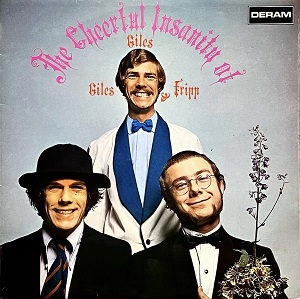
In 1968, brothers Michael (drums) and Peter Giles (bass and vocals) posted an ad looking for a “singing organist,” and Robbert Fripp (neither a singer nor an organist) replied. This trio recorded an album, The Cheerful Insanity of Giles, Giles and Fripp, which is an enjoyable-enough psychedelic folk record. The cover features what might be the only photo of Robert Fripp smiling. (He’s on the right, wearing glasses.) The guitar parts clearly presage what would eventually be heard in King Crimson’s first incarnation, but this is folkier and more psychedelic than anything that group would put out.
Cheerful Insanity at times reminds me of The Who’s psychedelic efforts, as well as other contemporaneous acts, like The Small Faces and Pink Floyd. Organ lends a rich character to the compositions, and the vocals are nice. However, frequent spoken word interludes detract from the experience. These attempts at humor are clunky and feel like a lesser version of Frank Zappa.
Looking to push their boundaries, the trio added Ian McDonald to the band–who provided keyboards, woodwinds, and reeds–and lyricist and artist Peter Sinfield. McDonald and Sinfield were already writing partners before joining what was still at the time Giles, Giles & Fripp. At the same time, Fripp pushed for the replacement of Peter Giles by his friend, vocalist and guitarist Greg Lake. Giles had strong pop inclinations, which clashed with Fripp’s increased interest in classical and improvisational music. Luckily for Fripp, Peter Giles was frustrated by the trio’s lack of success, and he left the band of his own accord.
With this new lineup (Fripp, Sinfield, Michael Giles, Lake, and McDonald), King Crimson was formed. McDonald wrote much of the band’s early material, though Fripp and Lake made significant contributions, too. Sinfield provided all the lyrics, and he is one of the few lyricists in progressive rock whose work I feel elevates their band’s compositions. He is a master of dark and abstract imagery, and his style suited the band’s early sound perfectly.
Sinfield said that this early incarnation of King Crimson purposefully strove to avoid anything popular-sounding. They made conscious decisions to use weird chords, obtuse structures, and odd time signatures. This attitude does come off as a bit try-hard to modern sensibilities, but it paid off for them.

King Crimson released their debut record in October 1969. Titled In the Court of the Crimson King, it was a smash commercial and critical success. I’ve read that the cumbersome song titles were due to a quirk of how royalties were calculated by the British recording industry at the time. With all the subsections listed, supposedly, the band would get credit (and royalties) for twelve songs instead of five. This explanation sounds plausible, but I’ve never read this account in a particularly reliable source, so it could easily be a bit of folklore or apocrypha.
The album cover is also one of the most striking in rock history. The screaming, melting face–painted using only red, blue, black, and white–is terrifying, anxiety-inducing, and iconic.
In the Court of the Crimson King begins with one of the band’s best-known songs. “21st Century Schizoid Man (Including “Mirrors”)”, inspired by Henry Kissinger’s brutal bombing campaign in Southeast Asia, is one of their absolute high points. The song’s main riff is fierce and unconventional, using guitar, sax, and distorted bass to scorch the listener. Greg Lake’s fuzzed vocals only add to the atmosphere. Following a pair of short verses, the song plunges full-bore into odd-time, jazzy madness. This composition is an astounding mission statement from the band, and even despite the many shifts in their sound over the years, the searing, experimental proto-metal of this song remained a key component of the act’s identity.
“I Talk to the Wind” is the only song on King Crimson’s debut without subsections, and it was the only one originally written for Giles, Giles & Fripp that made it onto this record. Warm flutes and reeds give this cut a floating, idyllic feel, and Lake’s vocals are delicate and alluring. Fripp’s guitarwork channels jazz once more, albeit in a more sedate form than on the album opener. I love “21st Century Schizoid Man”, but this is, for my money, a stronger overall composition and close to a perfect psychedelic folk piece.
Speaking of perfect (or near-perfect) compositions, side one of ItCotCK closes with “Epitaph (Including “March for No Reason” and “Tomorrow and Tomorrow”)”. Mournful clean guitar, dramatic Mellotron, and rolling percussion lend immense yet restrained weight to this song. Lake’s vocals are again a highlight, and the occasional stab of piano and acoustic guitar add wonderful, sharp contrasts to the song’s richness. In its midsection, reeds are given prominence over a minimal backing. “Epitaph” ends on a melodramatic note, but the band sells it, one hundred percent. This is not overblown; it is the perfect amount of blown.
Side two starts off quite promisingly. “Moonchild (Including “The Dream” and “The Illusion”)” begins as a subdued, morose, and very pretty piece. Haunting Mellotron, simple guitar, and the occasional bit of percussion meld to make a song which balances stark, ethereal eeriness with trepidatious hope. However, after about two-and-a-half minutes, what was up to this point a flawless album (in my eyes) hits an immense stumbling block. And this would be a stumbling block which would plague almost every single release King Crimson ever put out. Simply put: Robert Fripp loves improv, but he’s not very good at making it interesting.
“Moonchild” meanders for a punishing ten minutes of aimless jazz noodling. I actually never listened to the whole thing until about a year ago when I purchased a vinyl copy of this album and I was physically unable to skip this song’s extended jam. It is a dull, monotonous slog with nothing of value. It is a festering, open wound on this album’s face, and this album’s face is famously horrific enough as it is.
After the longest ten minutes of your life, the album’s final song–“The Court of the Crimson King (Including “The Return of the Fire Witch” and “The Dance of the Puppets”)”–is a majestic, glorious composition on which to end. Mellotron and multilayered vocals lend this cut a fittingly regal air, and Sinfield’s lyrics are gothic and fascinating. There’s a lovely, extended flute solo over gentle, folky backing between the verses, and the main theme roars back more powerful than ever after a brief calliope interlude.
It really is a pity “Moonchild” is ten minutes longer than it needs to be. Otherwise, this would be an absolutely perfect record.
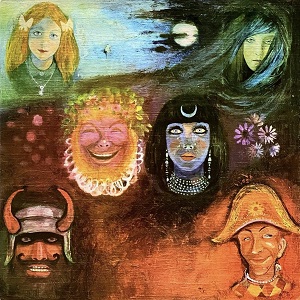
Less than a year later, King Crimson released their sophomore album: In the Court 2: Electric Boogaloo In the Wake of Poseidon.
Structurally, Wake is nearly identical to Court, despite there being quite a bit of churn in the band’s lineup. Such instability would be a recurring theme of these early releases.
Wind/keys player Ian McDonald quit after King Crimson’s US tour, citing a distaste for the harshness of the music, and drummer Michael Giles would leave after recording the album. (Fun fact: McDonald would eventually go on to co-found Foreigner, playing on their first three albums.) Fripp offered to leave the band, if it would convince McDonald and Giles to stay, as he considered the band more important than himself; but those two insisted that Fripp was more important to the band’s continued existence than they were.
Greg Lake was on his way out of the band to join Keith Emerson and Carl Palmer, but he still provided vocals on all but one song. Though he sang, Lake did not play bass on Wake. Instead, Peter Giles was invited back to the band. Fripp provided most of the keyboards, except for piano, which was played by Keith Tippett. Wind instruments are less prominent on this album, but when they do show up, they’re played by prolific prog saxophonist Mel Collins.
Wake features three brief, quiet pieces (or should I say, “peaces”?). The first of these, “Peace – A Beginning”, is ultimately forgettable. What follows is “22nd Century Schizoid Man” “Pictures of a City (Including “42nd at Treadmill”)”, a heavy, jazzy, sax-forward song with an extended, frenetic instrumental midsection. It’s decent enough, but it pales against its obvious progenitor.
“Cadence and Cascade” is a gentle acoustic ballad, and it is the one song here sung by someone other than Greg Lake. As far as ballads go, it’s not bad, but it is completely opposite the style most people associate with King Crimson.
The title track is this album’s answer to “Epitaph”. Mellotron and acoustic guitar alternate to give a sense of richness and pared-back austerity, and Lake’s vocals are impassioned. It might be a little longer than it needs to be, but I like it a lot.
Side two opens with the brief acoustic instrumental “Peace – A Theme”. Again, it’s fine, but unnecessary. This leads into the oddball, jazzy “Cat Food”, which was released as a single. King Crimson actually went on Top of the Pops to perform (or mime, more accurately) this song. It has a weird catchiness, and the chorus is pretty strong. This composition seems like a precursor to the direction King Crimson would take in the ‘80s: there’s a definite pop slant to it, but it’s still plenty strange.
(A slightly shortened version of “Cat Food” was released as a single, and it was backed with the B-side “Groon”, which is even jazzier and more dissonant than its A-side. This instrumental feels somewhat analogous to the extended instrumental section of “Moonchild”, albeit noticeably more fun. That is to say, it is an ultimately unnecessary improvisational instrumental.)
Following “Cat Food” is the 11-minute instrumental “The Devil’s Triangle (“Merday Morn”, “Hand of Scerion”, “Garden of Worm”)”. This piece evolved out of the band’s interpretation of the “Mars, the Bringer of War” section of Gustav Holst’s The Planets, which was a mainstay of their early live shows. I’ve heard some recordings from their 1969 concerts where they played “Mars”, and it is an amazing, snarling, metallic assault.
The version on Wake, though, has a long, slow fade-in, and drums and Mellotron are the primary instruments for most of its runtime. It swirls and swells and evokes the harsh polytonality of the orchestral original. In the end, despite all the grandiosity and bluster, its finale feels somewhat anticlimactic. Guitar and bass are too minimal, and there’s not enough textural variation. It’s a soup of various keyboard tones.
The album ends on “Peace – An End”, another short piece. This one, though, combines Lake’s vocals from “Beginning” and Fripp’s comforting acoustic guitar from “Theme”.
If you can’t tell, In the Wake of Poseidon isn’t my favorite King Crimson album. It’s not their worst, but it might be their most disappointing. This is definitely the least-creative the band ever was, as they effectively just made an inferior knock-off of their debut.
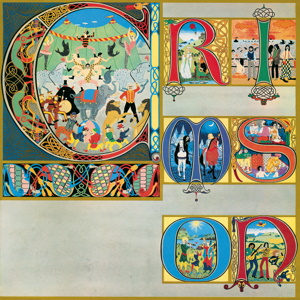
Wake saw more lineup churn in its wake. For King Crimson’s next album, Lizard, which released just seven months later, Gordon Haskell (who sang on “Cadence and Cascade”) joined as the new vocalist/bassist; and Andy McCulloch became the band’s new drummer. Mel Collins was promoted to full member, too. A number of session musicians were utilized, especially for keyboards and assorted wind instruments.
King Crimson has (almost) always had great album art, but the intricate, medieval-style lettering of Lizard might be my favorite. Woven in among the letters are images associated with the lyrics of five songs here.
I should note that I am reviewing Lizard based on Steven Wilson’s remaster of it. The original is muddy and murky, and Fripp himself called the album “unlistenable.” Wilson did an amazing job of decluttering things and letting the individual elements truly shine. Even Fripp has (kinda) come around on it. It’s clearly not his favorite, but King Crimson played some material off it during their 2016-2017 tours.
Twinkling electric piano and soulful vocals kick off “Cirkus (Including “Entry of the Chameleons”)”, but that quickly shifts to a darker mood. Stabs of ominous Mellotron contrast beautifully against twangy acoustic guitar. Lizard is King Crimson’s most keyboard-forward album, and I’ve always appreciated that unique character. Even before Steven Wilson’s remaster, I might not have enjoyed it as much, but I appreciated its place in the band’s oeuvre. Despite all these lovely textures, this song (and most of the others) do feel a bit long.
“Indoor Games”, compared to the drama of the opening cut, has a bouncier, more lighthearted and fun feel to it. Synthesizers and saxophones twist in instrumental moments, and the verses are underpinned with Fripp’s unique, idiosyncratic guitarwork. Despite the relatively light, poppy mood, there are plenty of strange jazz, classical, and avant-garde elements on display here. Some of the instrumental futzing-about in the song’s middle drags on for a bit, but it’s not terrible.
At The time Lizard was being recorded, The Beatles were going through a very messy, very public break-up, and “Happy Family” documents public perception of that drama. The vocals on this song are run through strange effects, and bizarre, piercing guitar and piano lines jump between the left and right audio channels rapidly. I like this song overall, but it does show Fripp leaning perhaps a bit too heavily on chords that eschew traditional considerations of tonality. The jazzy guitar noodling is especially egregious here, and even the awesome lead synth line (played by Peter Sinfield) couldn’t fully abrogate this cut’s excesses.
The final song on side one is the brief “Lady of the Dancing Water”. It’s a short, sweet acoustic ballad that adeptly blends folk and jazz elements. It’s a nice palate cleanser after the strange, dense songs that preceded it.
Side two is consumed by the 23-minute suite “Lizard”, King Crimson’s longest studio recording. Jon Anderson of Yes provides vocals for the first part of the song, and he’s a great inclusion. There’s a sense of foreboding in the verses, but the chorus is warm and hopeful, despite the less-than-cheery lyrics.
(In doing some reading for this piece, it turns out Jon Anderson’s guest inclusion wasn’t as simple as Fripp & Co. inviting a prog-rock peer to work with them, like Van der Graaf Generator did with Robert Fripp. There are rumors that Haskell had already left the band over creative differences with Fripp, and other rumors simply state that this song was written too high for Haskell’s range.)
After those very pleasant first four minutes, “Lizard” unfortunately goes a bit off the rails. To reiterate, I enjoy “Lizard” overall, but it suffers from the same ills as the other songs on the album. It’s overlong, unfocused, and too-often-dissonant. Before Wilson’s remaster, it really was a chore to get through the “Bolero” section.
Cornet, trombone, and piano get too much time in the forefront, bringing this opus to a rather Miles Davis-y place I’m not particularly fond of. There’s a bolero beat underpinning all this activity, and it’s a very long six minutes.
Haskell shows up about halfway through the song, as it enters its third movement. This segment begins with a stripped-back, tense arrangement, and a piercing English horn adds to the tension. All of this complements his voice wonderfully. The song finally regains a sense of purpose as the Mellotron comes in, leading the way on a weary, determined march. There’s a great, gritty sax line that barges in, but the backing is too scattered to really support it with the oomph it needs, at least at first. Once things finally coalesce, this piece becomes what “The Devil’s Triangle” was striving for: dark, impactful, classical-rock fusion. It’s just a pity it takes such a meandering path.
Despite my many gripes, Lizard is greater than the sum of its parts.
The conclusion of the Lizard recording sessions came with more (expected) bandmember turnover. As mentioned above, vocalist/bassist Gordon Haskell quit the band. He drew his primary influences from soul and Motown, so it’s clear why he’d be a poor creative fit for King Crimson. Drummer Andy McCulloch would leave the band not long after Haskell. Haskell was replaced by Boz Burrell (one of the future founding members of Bad Company), and McCulloch’s replacement was Ian Wallace. As is par for the course so far, this lineup would persist for just one album: 1971’s Islands.
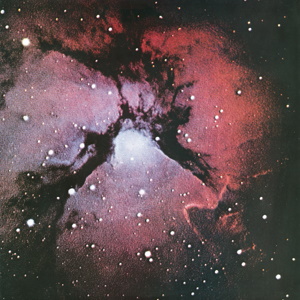
This section of the Deep Dive is probably going to be my hottest take. I don’t like Islands. It is a sleepy, boring, aimless record that does little and says less. This was the first time in probably seven or more years I’d listened to the album, and I’d forgotten how many heavy moments there are here, since the string-heavy bookends always left the biggest (negative) impressions on me. But even when Fripp takes the lead, his playing is often overly-busy and scattershot.
I genuinely do not understand the love this album gets. Normally, if a band has a well-received album I’m not a fan of, I can at least get why. This is an exception to that. Yes’s Fragile is inconsistent and half-filler, but the highs are so high, I can see why people would put it so far up in their respective lists. I’m relatively critical of Wish You Were Here, but I understand why it resonates with people. Even The Wall and Hand. Cannot. Erase.–two records I didn’t quite pan but gave overall-lackluster reviews to–have elements that make me understand why people like them so much. To me, Islands has no such redeeming qualities.
The album starts with the ten-minute “Formentera Lady”. Jazz, classical, and chamber music influences are prominent throughout the whole record, and this song is no exception. Bowed double bass, piano, and flute swirl for a while before the vocals begin. Burrell’s voice is very nice here, and these opening moments have some promise; it reminds me a lot of Atomic Rooster’s gentler moments. However, it becomes clear that this song is content to just sort of drift along, alternating between subdued verses and the slightly-peppier chorus. Much of the final three minutes is consumed by a noodly sax solo and some warbling, wordless vocals. I can envision what the band was going for, but this simply isn’t a success.
“Sailor’s Tale” is my favorite song on the album. Opening with a high-energy, jazzy rhythm, guitar and sax share the lead. Some of the soloing can feel a bit purposeless, but at least it’s relatively entertaining. When things slow down, Fripp throws some strange, clattering guitar chords over the top of lush Mellotron, and it works pretty well. The feeling of the song becomes urgent as the pace picks back up, and I especially like the drumming in this closing section. The song does end on a too-long drone, but I’ll take what enjoyment I can get from Islands.
“The Letters” isn’t without its redeeming qualities, either. The saxophones here have some great punch and power to them, and they contrast nicely against the quiet, calm verse. Moving deeper into the song, though, the instrumental section turns into a bunch of noisy nonsense. Burrell’s vocals in the last minute are impassioned, and he’s capable of being both delicate and strong.
Side two opens with “Ladies of the Road”. Sinfield’s lyrics aren’t great here, and Burrell’s delivery doesn’t help them. This is a song about groupies, and it’s trying to be dirty and raunchy, but it comes off as stilted and awkward. There are some blues flavors here, but Fripp clearly can’t quite commit to it, constantly tossing in jazzy and avant-garde licks that don’t really fit. During quiet moments, I do like the more complex vocal arrangements. The composition of this song does give a hint of where Fripp would take King Crimson in the near future: it is relatively stark, austere, and heavy.
“Prelude: Song of the Gulls” is an alright little instrumental. It contains no rock instrumentation, with a small string arrangement and Collins’s flute being the only elements here. It doesn’t make much of an impression, and it doesn’t really add much.
It doesn’t even serve as a natural introduction to the ten-minute title track. Piano, vocals, and bass flute start this song off gently, but it doesn’t feel like an extension of “Prelude”. In returning to Islands after so long, I found more to like in the preceding songs than I recalled (especially songs 2-4), but the unending, uninteresting, and aimless title track incinerates any goodwill I may have been fostering toward this record. It just keeps running in circles, adding nothing new. In its second half, trumpet and percussion enter, and it’s obvious that a lot of post-rock bands that I’m not too fond of took inspiration from this song.
After a minute of silence there’s a hidden track, but it’s just studio chatter and the string arrangement tuning up. I don’t know why they included this.
Certain CD reissues have included the previously-unreleased bonus track “A Peacemaking Stint Unrolls”, and it’s more interesting than most of the record. The guitar is wiry and jittery, and Fripp’s nimble riffs sound like a precursor to math rock. Bits of riffs that would be reused in future songs can be heard here, so this is a unique artifact of the band’s songwriting process.
SeKction II: Things Get Heavy (1972-1975)
You know the drill by this point. Say it with me! Following the release of Islands, there was significant turnover in the band’s lineup.
This was the most extreme turnover the band had had yet, though. Robert Fripp would be the only member of the previous incarnation to appear on the band’s next release. (Wind instrument player Mel Collins claims Fripp asked him to stay on, but he opted not to.) Fripp had been butting heads with co-creative leader and lyricist Peter Sinfield, and Fripp forced Sinfield out after the Islands tour. He also fired the rest of the band, but Sinfield’s departure is what really heralded the sharp change in sound we were about to hear from King Crimson.
The band’s new bassist/vocalist was John Wetton, a longtime friend of Fripp’s who had previously lobbied to join the band. (He would later go on to be one of the founding members of Asia, along with ex-members of Yes and ELP. God, that’s a disappointing band, based on the members’ previous acts.) Fripp recruited two percussionists for the band’s next project: free-improvisational percussionist Jamie Muir, and former Yes drummer Bill Bruford. Rounding out the group was violinist and keyboardist David Cross.
(Speaking of Bruford, I remember I once saw a thread on the progressive rock subreddit about who the best prog rock drummer is. OP put forth Neil Peart as his suggestion, but he said a friend of his was arguing for Phil Collins. Before even clicking through to see the replies, I thought, “Everyone’s going to be saying, ‘You’re both wrong. It’s clearly Bill Bruford.’” And sure enough, every single comment said something to the effect of, “You’re both wrong. It’s clearly Bill Bruford.” Bruford did some great work with Yes, but King Crimson’s jazzier influences really let him shine, and his best work can be heard on these mid ‘70s King Crimson records.)

The result of this new quintet lineup was 1973’s Larks’ Tongues in Aspic. It is a harsh, austere record with no shortage of jazz and avant-garde influences. It’s also the band’s best album, for my money.
There’s also an argument to be made for this being the first progressive metal record. Progressive metal is usually credited as having begun in the mid 1980s with acts like Fates Warning, Dream Theater, and Queensrÿche, and I can understand why. Prior to the mid ‘80s, “heavy metal” was a pretty squishy term, and many acts who pioneered metal rejected the label (most notably Black Sabbath and Motörhead). Similarly, many things considered metal in the ‘70s–such as AC/DC and Led Zeppelin–are nowadays thought of as metal-adjacent or very influential on metal, but not as being metal themselves.
Larks’ Tongues is not 100% metal, but no early progressive metal album is. Hell, even today, no Dream Theater album is 100% metal. With that caveat in mind, the heavy music here still holds up, and I think all but the kvltest-of-the-kvlt elitists would concede that the two-part, twenty-minute title track would still be classifiable as “metal.”
“Larks’ Tongues in Aspic (Part I)” opens with the gentle tinkling of chimes from Muir’s wide array of percussion instruments. After a few minutes of quiet ambiance, high-anxiety violins and distorted guitars charge in to bring a sense of doom. Bruford’s drumming is immediately noticeable as an upgrade over previous ones, and Wetton is also the band’s flashiest bassist so far. The riffs in this song are strange, tense, and unsettling. Once it really gets moving, it does a great job at keeping the listener unsettled. It’s never clear what strange idea is lurking around the next musical corner.
About midway through, Fripp lessens the distortion on his guitar, opting for a jangly, skittering tone, and the other members of the band are given a great opportunity to flex their muscles. Moments of quiet are woven in naturally amidst the more aggressive sections. (There’s also a particular violin line around the 10-minute mark that strongly reminds me of a bit of music in Beetlejuice. I just find that interesting.)
Next is “Book of Saturday”, a pleasant little ballad. The guitar has a comforting jazz flavor, and Wetton’s vocals are great. He’s probably my favorite of King Crimson’s many singers. “Exiles” is another fairly gentle piece, where Cross’s violin is utilized excellently. The Mellotron is relatively subtle, but it provides a nice depth to the overall sound. However, this is probably my least favorite song on the album, as it feels a bit too long and a smidge repetitious.
There’s a determined, plodding drive to “Easy Money”. It’s also a place where Muir’s unconventional percussive flourishes really add a lot. The verses are minimal, quiet, and convey a sense of restrained tension; and the chorus is big and powerful. The build-up is fantastic.
“The Talking Drum” has a long, quiet introduction. It is so long and quiet, in fact, that I consider it to be one of the few slip-ups on the album. If I’m listening to music with the volume somewhat low and this comes on, I usually need to check to see if something is actually playing. However, in a quiet environment, one can hear the pitter-patter of Muir’s percussion. Around two-and-a-half minutes, the rest of the band joins in, though also quietly, at first. This gradual fade-in continues until, eventually, violin and guitar can be heard sliding across each other and the three-man rhythm section lays down a fun, funky beat. The song culminates in an anxious jam that leads right into the second part of the title track.
“Larks’ Tongues in Aspic (Part II)” opens with a heavy, ragged, odd-meter riff. Muir’s uncommon percussion is a fantastic inclusion, and the violin makes this piece sound like a metallic version of Mahavishnu Orchestra. The song moves through moments of aggression and quiet, but it remains focused, overall. Fripp’s guitar riff keeps the band rooted to one idea, and Wetton and Cross both get plenty of opportunities to show off. As the song swells near its midpoint, it bursts into a lurching breakdown that presages many structural developments in modern metal. Add on top of that Cross’ squealing violin solo, and it makes for a fantastic cut.
Following the release of Larks’ Tongues, the band’s lineup remained fairly stable. Suffering from burnout, Jamie Muir left, but the other members all stayed on board.
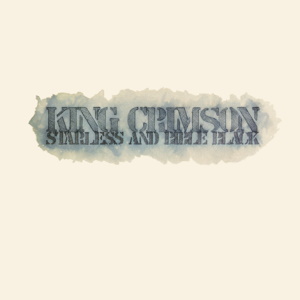
Their next album, Starless and Bible Black, is somewhat odd, in regard to how it was recorded. The band wanted to better capture the energy of their live shows, so most of these songs were tracked in concert. However, the work done in the studio was so extensive that this release is considered to be part of King Crimson’s studio discography. Of the eight songs on the album, only two were entirely recorded in the studio.
One of these in-studio songs, “The Great Deceiver”, opens the album. It’s got a high-energy, distorted main riff, which is vaguely reminiscent of some of the band’s past work, such as “21st Century Schizoid Man”. The verse is pretty loose, but it pulls together into a tight, catchy chorus.
“Lament”, the other in-studio track, follows. It starts off gentler than the opener, but it delves into a fuzzy, frazzled sound in its second verse. Wetton’s bass playing is a highlight here, throbbing and popping beneath Fripp’s guitar.
I like these two studio songs a lot. The stuff that was recorded live, though, often underscores my issues with Fripp’s focus on improv.
“We’ll Let You Know” is an entirely improvised piece, and it sounds like it. The song opens with unfocused, unsteady noodling. Bruford does a good job working with what he was given, but this song doesn’t really ever come together into anything until the final 45 seconds. Even then, it’s a decent-enough jam, but it’s nothing too noteworthy.
“The Night Watch” has a bit more structure and features some studio overdubs, due to some hardware issues the band had at the concert. Cross’s violin is lovely, and Wetton gives a great vocal performance. This is a fairly sweet, gentle piece, in the same vein as “Exiles”. Fripp gets in some good soloing, and the Mellotron enriches the piece further.
Another improvised piece follows: “Trio”. This song is titled as such because Bruford does not play on it. However, he’s still credited as a co-writer, since he made an active decision not to add any drums. Featuring just bass, viola, and Mellotron, it’s actually pretty good, as far as improv goes. It’s quiet, meditative, relaxing, and with a vague sense of warm nostalgia.
Side one ends on “The Mincer”, yet another bit of improvised music. (Wetton’s vocals were overdubbed in the studio.) The first half feels a lot like a Pink Floyd song from 1969. There’s a hazy, woozy atmosphere, and keys and guitar both vaguely float about. As the song progresses, Fripp’s and Bruford’s styles become more recognizably Crimsonian. Unfortunately, this track suffers from the same problem that afflicts “We’ll Let You Know”. A lot of the playing here comes off as noodling that doesn’t amount to much of anything. It hints vaguely at what the band might get up to eventually, but they never build to that hoped-for high.
Side two consists of two long instrumentals. The first, the improvised title track, starts off with more of the aimless ambiance I’ve come to expect from this band’s unscripted work. Something of a recognizable pulse finally emerges a bit before the five-minute mark, and Bruford and Wetton really shine. Cross’s work on the Mellotron is fine, but Fripp’s continual strangulation of his guitar grows tiresome for me. At least the song has a satisfying (though brief) climax, where Fripp and Cross both pull out some long, twisted notes.
“Fracture” has more to immediately grab onto. (I also couldn’t find any source that explicitly identified this track as being improvised, so there may be more structure to this song than other ones on the album.) The main riff is lurching and full of dread, and the effects applied to Cross’s violin remind me of David Jackson’s saxophones in Van der Graaf Generator. It eventually moves into a section of quiet claustrophobia, where violin and clean guitar tread delicately around one another. “Larks’ Tongues in Aspic (Part II)” gets a brief revisitation, and it really sounds powerful in a live setting. Parts of this song can drag on a bit, but it’s still a strong conclusion to an otherwise-spotty record.
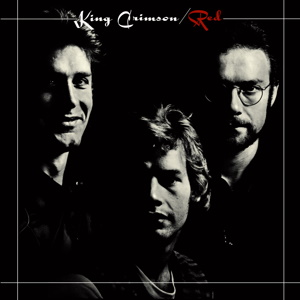
For their next studio album, Fripp asked David Cross to leave the band, bringing King Crimson down to just the trio of Fripp, Wetton, and Bruford. The resultant album, Red, released barely six months after Starless and Bible Black, and was the band’s heaviest yet. This result was due in large part to the influence of Wetton and Bruford, as Fripp took a more collaborative tack on the songwriting here.
Red opens on its title track, which features a pounding, upward riff that transitions into a determined passage. Wetton’s bass adds a ton of weight, and Bruford’s drumming is deft and nimble. A percussionless passage near this song’s midpoint features some wonderful, creepy cello before launching back into a slightly-slowed-down take on the main riff. “Red” is one of the most seminal instrumental tracks in the progressive rock canon, right up there with the likes of “YYZ” and “The Great Gig in the Sky”.
“Fallen Angel” is warm and sweet; Wetton’s voice is soulful, and oboe brings a wonderful coziness to the verses. King Crimson have usually been good at these slow songs, and this is one of their shining highlights in this style. It’s brought to new heights here with the swirling, distorted, plaintive chorus. Wetton’s bass growls, a cornet wails, and Fripp’s jagged strumming adds to the unease. Of course, Bruford is in top form here.
There’s a sense of anxious urgency to “One More Red Nightmare”. The riff is dark and haunting, and Bruford’s clattering percussion adds a lot. When Wetton’s vocals come in, the verse is groovy and infectious. Heavily-affected handclaps bring some nice textural variation and add to the track’s surprising catchiness. Founding member of the band Ian McDonald gets a cameo with a sax solo that adds a lot to the dreamlike drama.
Side two’s opening track–“Providence”–sees the one hiccup on Red. Though nowhere near as bad a blight as the final ten minutes of “Moonchild”, this improv-heavy instrumental falls flat in comparison to the other four masterpieces on this album. David Cross shows back up to play violin, which adds a delicate and often-unsettling character over Wetton’s growling bass.
As with many of King Crimson’s other extended improv jams, “Providence” often hints at something interesting that might happen, but it never really comes to fruition. There’s a sinister bit of bass here, and the drums feel like they could lead into something there, but it takes until five-and-a-half minutes in that anything even remotely interesting happens. Even then, it feels like the seed of a good song that still needs to germinate. “Providence” closes on a good jam, but it’s not worth the build-up. Yes, some might praise the raw, unfiltered character of this performance, but I (usually) like my studio records to have more solid roots and clearer planning. In many ways, Red is a better album than Larks’ Tongues, but the aimless bloat of this song prevents it from grabbing the top spot on my list.
Red closes on “Starless”. Its opening moments – full of Mellotron, mellow guitar, and jazzy bass – harken back to the sounds of the band’s debut record. Both Ian McDonald and Mel Collins show up on this song to provide saxophone. Wetton’s vocal performance is as powerful as ever, and there’s a strong sense of something swelling up beneath this song’s calm surface.
The song shifts to a more stripped-back arrangement for a while, and there is a palpable, growing sense of disquiet. Fripp’s simple guitar pattern is slightly off kilter, and Bruford’s drumming is fittingly askew. Wetton’s bass grows in prominence, and it eventually turns into a massive, blustering storm. After a brief, jittery guitar break, the song dives into a speedy, jazzy sax solo, and Wetton and Bruford again flaunt their impressive technical skills.
Robert Fripp had been growing increasingly disenchanted with the music industry throughout the Red recording sessions. He did not wish to go on tour again, and he tried to bring in Ian McDonald to replace himself. When King Crimson’s management nixed that idea, Fripp instead dissolved the band.
SeKction III: Progressive New Wave (1980-1985)
After going on some spiritual retreats and working with a handful of other artists throughout the late 1970s, Robert Fripp felt ready to have his own band again by 1980. He recruited Bill Bruford to be his drummer, though he had no intention at the time of resurrecting the King Crimson name. Fripp also brought on American musician Adrian Belew to handle vocals, additional guitars, and lyric-writing. After some auditions, another American–Tony Levin–was tapped to play bass.
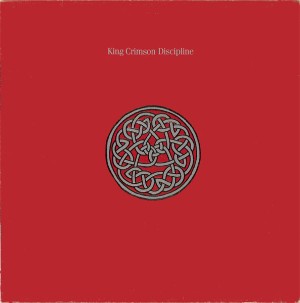
Initially called Discipline, this quartet featured influences from new wave, post-punk, and funk, and was starkly different from every prior King Crimson incarnation. The act was eventually rebranded as King Crimson, however, and an album called Discipline was released in late 1981.
The album opens with Tony Levin’s unique rubbery bass on “Elephant Talk”. (It may be a Chapman stick, a two-handed, tapped hybrid bass/guitar that is a specialty of Levin’s.) The guitars clearly draw a lot from new wave, both in style and tone. The lyrics are quirky, with each stanza containing different words for talking that start with the letters A through E. It’s groovy and fun, and the occasional big, bent guitar note calls to mind elephants trumpeting.
“Frame by Frame” has a high-energy opening riff that evokes images of film frames flying by on rapidly-spinning reels. The verse is mellower, and Tony Levin’s backing vocals add a nice level of warmth.
What follows is my least-favorite song on the album. “Matte Kudasai” is a slow, schmaltzy ‘80s ballad, and that’s simply a style I don’t find enjoyable. King Crimson has no shortage of good slow songs in their catalog, but this is one of very few King Crimson songs to sound like a product of its time in a bad way.
“Indiscipline” is the most typically-Crimsonian song so far, and it features a great, dark, twisting lead guitar line over a heavy, plodding beat. The vocals are spoken over a backing of primarily bass guitar, and it works. This song is all jagged edges and tumbling rhythms, and that swirling chaos works beautifully.
My favorite song on Discipline, though, is “Thela Hun Ginjeet”. (The title is an anagram for “heat in the jungle,” a reference to urban crime, the topic of this song.) Belew’s vocal performance is dramatic, and the rapid, anxious strumming helps cultivate a tense atmosphere. The spoken-word segments consist of Belew talking about experiences while walking around New York City trying to get other field recordings. Fripp’s lead guitar is often stretched out, and there’s a strange catchiness to it all.
“The Sheltering Sky” is a mellow instrumental track. Bruford’s percussion is electronic but reminiscent of woodblocks. It adds a relaxing vibe to the track, along with the laid-back rhythm guitar and the gentle throb of Levin’s bass. Fripp’s lead guitar synthesizer has a less-pleasant tone to it, and its whining and squealing grows tiresome rather quickly. There are some good ideas here, but this is the one place on Discipline where Fripp’s love of improv hampers things.
Discipline ends on its title track, an instrumental cut that is a great distillation of the album’s overall sounds. Clean guitar lines tie knots around each other, and Levin and Bruford give the song a nice bit of funk.
CD reissues have also included a bonus track: an alternative version of “Matte Kudasai”. This alternative version is much better than the one featured on the album, and it sounds completely different. This one is a tense instrumental full of jagged guitars and swirling synthesizer lines. It’s clearly a rough, unfinished version, as you can hear someone calling out instructions to the rest of the band every now and then.
(Disregard all that. There was a goof here that I explain down in SeKction IV.)

Less than a year after Discipline, King Crimson released their next album, Beat. For the first time in the band’s history, their lineup remained identical on consecutive albums. Good job, guys! Beat draws much of its lyrical inspiration from writers of the Beat generation. I don’t particularly care for Beat writers, so it’s a good thing I’m not a lyrics guy.
“Neal and Jack and Me” features twangy, spiraling guitars, similar to those on Discipline, but between the rhythm and Belew’s singing, this sounds more like a Talking Heads song than the hyper-technical, math-y new wave of the preceding album. (Belew was an occasional live guitarist for the Talking Heads. During a period of especially bad intra-band drama, Tina Weymouth and Chris Frantz approached Belew about replacing David Byrne, to which Belew declined.)
I’ll continue the Talking Heads comparison on “Heartbeat”. This song feels almost conventional. It’s alright, but this poppy, melodic, mid-tempo cut reminds me of 90125, insofar as this is a good song, but not a particularly good King Crimson song (just as 90125 is a good album, but not a particularly good Yes album).
King Crimson finally starts sounding like (‘80s) King Crimson on the instrumental “Sartori in Tangier”. Fripp’s guitar synthesizer squeaks out an unusual lead as Levin and Belew weave a wiry, rubbery backing. It’s dark and moody, and it gives Levin a chance to flex his skills on the Chapman stick.
A tapping pattern opens “Waiting Man”, and there’s a warm, vaguely-Latin feel to the first verse. There’s no percussion for the first half of this song, and even when it comes in, Bruford is fairly restrained.
Side two of Beat opens with “Neurotica”, and rather than Talking Heads, the first riff sounds much Rush-ier. Belew’s rapidfire babbling and the loose chaos of the verses establish this as a unique song. Structurally, this reminds me a lot of “Elephant Talk”, but it’s not a direct ripoff. I love all the weird flourishes Fripp and Belew put into the guitar lines.
“Two Hands” is a slower, quieter song, and I like Bruford’s precise performance. Overall, though, this song doesn’t make much of an impression. “The Howler”, meanwhile, is fun and replete with strange guitar and synth chords, as well as nimble instrumental lines. This isn’t Belew’s strongest vocal performance, but I do like the swirling, uneasy guitar solo.
Beat ends on the instrumental “Requiem”. There’s an airy ambiance as the song opens with an extended, speedy guitar solo. Technically, it’s impressive, but it fails to have much impact. As the song progresses, it only becomes more chaotic and tedious. This is clearly the band indulging in an extended improvisation, and I think I’ve made my thoughts known on how that usually turns out.
On CD reissues, a bonus track titled “Absent Lovers” was included, and I like it a lot. It’s full of pep and verve, and I think it would have been a strong inclusion on Beat.
Overall, Beat is alright. It is comparable to In the Wake of Poseidon in that it’s not a bad album, but it feels like a weaker version of the album which preceded it. King Crimson did this math-y new wave pretty well most of the time, but moments on Beat sounded a bit underbaked or uninspired.
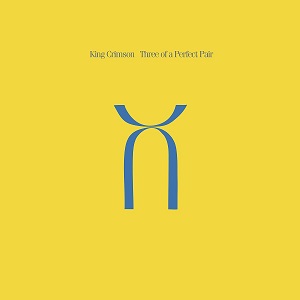
King Crimson’s next album was 1984’s Three of a Perfect Pair. Its oxymoronic title belies the somewhat jumbled nature of its writing, with the two sides of the record having their own themes. Side one (called “The Left Side”) features poppier, more accessible music, and side two (“The Right Side”) leans more into King Crimson’s experimental and improvisational tendencies. (When bonus tracks were added for a CD remaster, they were dubbed “The Other Side”.)
Also, the lineup remained the same here. Good job, guys!
Three of a Perfect Pair opens with its title track, and it’s pretty typical ‘80s Crimson. Fripp and Belew play interlocking clean guitar lines that are alternatingly smooth and jagged, Levin and Bruford provide some nice funk, and Belew’s vocal performance is strong. For the most part, this piece doesn’t stand out among their ‘80s output, but the synth solo in the middle is wonderful.
“Model Man” is warm and poppy, and it’s yet another song I could have mistaken for a Talking Heads piece. “Sleepless” features a distinctive slap bass opening that showcases Tony Levin’s skills as an instrumentalist. It’s darker and tenser than the preceding cuts, and it was a modestly successful single. This song is a hair longer than it needs to be, but it’s solid overall. (Three different and unnecessary remixes are included as bonus tracks on the 30th anniversary remaster of this album.)
“Man with an Open Heart” continues with the poppy trend of the Left Side, albeit with some of Fripp’s signature unorthodox guitar chords.
The Left Side ends with eerie electronic sounds on “Nuages (That Which Passes, Passes Like Clouds)”, and eerie electronic sounds is all it offers. There’s no real progression or build in tension or structure. It just sorta floats along. It sounds like background music for a video game from 1998.
Kicking off The Right Side is “Industry”, which starts in a vein similar to “Nuages”. This seven-minute piece meanders for its first couple minutes before something of a backbone emerges. As the name hints, the band draws from Industrial music here. The tones are austere, and there’s a certain robotic nature to this piece. Unfortunately, the various elements of this song don’t ever coalesce into anything noteworthy. It’s a lot like many of King Crimson’s ‘70s improvisations, but with a 1980s sound palette.
“Dig Me” has some better development, but it comes off as somewhat slapped-together. The verses feel like they’re in a constant state of disintegration, but the chorus is majestic and melodic; the two don’t fit together. This is followed by the instrumental “No Warning”, and it suffers from aimlessness similar to the two preceding instrumentals on this record. At least Bruford gets a chance to show off here.
Three of a Perfect Pair closes on “Larks’ Tongues in Aspic (Part III)”. The album cover is meant to be a simplified interpretation of the original Larks’ Tongues album cover, and the themes of contrast throughout the album make sense in the context of a sequel. Following a jittery intro, The Right Side finally has something that feels like a real song. The music is tense, energetic, and thoughtful. Somehow, this composition manages to feel like a new wave sequel to the original, and it works shockingly well.
Three of a Perfect Pair is a spotty record. It’s also one of the band’s blandest. The closing cut is the best of the bunch by a wide margin. There are a couple other decent tracks, but much of this record comes off as disappointingly generic.
Aside from the above-mentioned “Sleepless” remixes, The Other Side bonus tracks include three other experiments. One, titled “The King Crimson Barbershop”, is a Tony Levin composition featuring everyone except Robert Fripp doing a barbershop trio. It’s goofy, silly, and totally unserious. This is the quintessential super-unnecessary-no-it’s-not-going-on-the-album-why-would-you-even-ask-but-fine-it-can-be-a-bonus-track-now-that-it’s-been-30-years song.
“Industrial Zone A” is a short instrumental focusing on menacing ambiance. “Industrial Zone B” is a four-minute instrumental with a bit more meat on its bones, though it still suffers from a lack of direction.
Following the tour for this album, Robert Fripp again dissolved the band, ten years after he forced its prior hiatus. As with the previous instance, this was entirely Robert Fripp’s decision; Belew found out about the band’s dissolution through an article in a music magazine, not unlike Jethro Tull’s semi-involuntary personnel shuffle of 1980.
SeKction IV: ProjeKcts Galore! (1994-2011)
After working with other musicians on other projects throughout the 1980s and into the 1990s, Fripp began to reassemble King Crimson in an expanded form. He called back the three other members of the ‘80s lineup, as well as Chapman stick player Trey Gunn (who had previously worked with Fripp) and ex-Mr. Mister drummer Pat Mastelotto. This six-man lineup came to be known as the “double trio.”
(A side note about what Robert Fripp was up to in the ‘80s. He started a series of guitar classes called Guitar Craft, and for that he pioneered a new guitar tuning, which he called New Standard Tuning. NST is an all-fifths tuning inspired by the tuning on classical stringed instruments like the cello and violin. “New Standard” was and is something of an aspirational name, as well. Almost no one outside of Fripp’s direct orbit uses NST, and it’s often impractical. Special NST strings are needed to play it effectively, as NST’s range is wider than that of standard guitar tuning. The highest string is higher, resulting in higher strain on the strings and making them more prone to snap; and the lowest string is lower, meaning typical strings are too slack to make a good tone. Calling something so quirky and impractical “New Standard” seems to track pretty well with Robert Fripp’s whole musical ethos.)
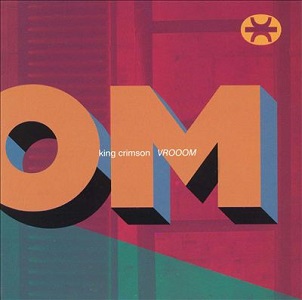
This sextet’s first release together was the EP VROOOM, and most of VROOOM would be rerecorded for their next full-length release. This was meant to serve as a music appetizer. It was supposed to whet the music-listening audience’s appetite after ten long, King Crimson-less years. Considering the minimal differences between the versions of the songs present on VROOOM and THRAK, I’m not planning to dive into the cuts that appear on both and are effectively the same. Otherwise, I’ll just be repeating myself a lot.
“Cage”, high-energy 90-second cut. It draws from bluegrass and post-punk, and it reminds me a lot of Primus. I never would have expected this sort of thing from King Crimson, but it works really well.
“Thrak” would go on to be rerecorded for their next album, but the version on here is nearly twice as long as the album version. The percussion steals the show, skittering and scattering as the stringed instruments twist and squeal. It does go on for longer than it needs to, but it’s an interesting cut with some direct parallels to the band’s heaviest ‘70s output.
The only other song unique to this EP is “When I Say Stop, Continue”. It sounds like it belongs on Starless and Bible Black, and I mean that in the worst way possible. It’s a groaning, aimless, meandering instrumental. In the last minute, the drummers establish a good groove, but the guitars and basses continue their caterwauling.
VROOOM is a pretty solid EP. It’s utterly unnecessary in light of what came next, but given the context of its release, it’s good.
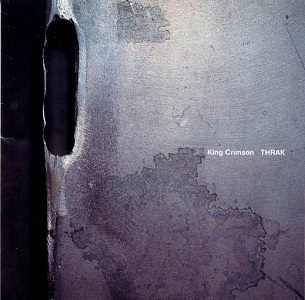
Coming about six months after VROOOM was the double trio’s first full length album, THRAK. THRAK features rerecordings of most of the songs on VROOOM, starting with that EP’s title track. It’s still a dark, heavy monster that expertly balances delicate clean passages against its stormier moments. “VROOOM”’s second part has been split off into its own song here, “Coda: Marine 475”, and it almost sounds like some sort of demented Abbey Road outtake. The subtle hints of psychedelia mesh quite well with King Crimson’s prog metal base.
A wobbly, swirling riff kicks off “Dinosaur”, and Belew’s vocal delivery is strongly reminiscent of David Bowie. More hints of late ‘60s pop are evident in the melody and chord progressions, and it’s a truly unique blend, especially in 1995. The double rhythm section adds an incredible dynamism.
“Walking on Air” has a dreamier feel to it, again expertly blending a vaguely late ‘60s aesthetic with King Crimson’s ever-present experimentalism. This is another strong entry in King Crimson’s history of slow songs (though its ending is a hair more dragged out than it needs to be). It’s jazzy and warm with a vaguely tropical feel to the rhythm. This piece is followed by the instrumental “B’Boom”, which puts the drummers in the foreground over an ominous soundscape. The track features some exciting rhythmic work in its second half, but there’s not really enough here to justify this being a four-minute song. It could’ve been a fun two-minute interlude.
Another instrumental, THRAK’s title track, comes next. The guitars interlock with jagged riffs, and the percussion sounds nearly robotic at points (but in a good, sci-fi sort of way). Parts of this song remind me of moments on Red.
“Inner Garden I” is a short, creepy piece that cultivates a sense of foreboding. The transition, then, to the very funky “People” is jarring. It’s fun and jumpy with skittering guitar, slap bass, and light percussion. The chorus is catchy and propulsive, but some of the soloing comes off as awkward. Its second half is more atmospheric and lingers longer than it needs to, but the two halves still fit together naturally.
“Radio I” is a 45-second interlude of synth effects that serves no purpose. “One Time”, though, has an inviting bassline and a laid-back feel. However, it doesn’t amount to much, and it’s around here that it starts to feel like King Crimson may have (to a degree) succumbed to the common 1990s curse of including songs that normally wouldn’t have made an album in years prior, just because a CD can hold 80 minutes of music. (For the record, THRAK is only about 10 minutes longer than the band’s previous longest release, but it’s a far better outcome than the obscene bloat partaken in by acts like Rush and Pink Floyd.) “Radio II” is equally as pointless as the first, and “Inner Garden II” doesn’t differ in any meaningful way from the first part. It’s fine in isolation, but I don’t see the point of including the two parts like this.
There’s a surprising amount of blues influence to the main riff of “Sex Sleep Eat Drink Dream”, and some of that late ‘60s pop sensibility witnessed earlier on the album shows up again, too. The track oozes easy confidence, and the band’s ability to plunge into orchestrated chaos is impressive.
THRAK ends on the two-part, nine-minute instrumental “VROOOM VROOOM”. The main body of it makes numerous allusions to past King Crimson songs, most notably “Red”. The riffs buzz aggressively, and both drummers do a great job at keeping things plowing forward. There’s a hard gap between “VROOOM VROOOM” and “VROOOM VROOOM: Coda” which kills the momentum. The coda fades in slowly and has a lurching main riff, but once it gets going, it’s able to make up for that disruptive moment of silence.
Following the tour in support of THRAK, Robert Fripp found himself frustrated with the quality of the music the band was writing at their rehearsals. Instead of officially disbanding, King Crimson was put on pause, and the members formed groups of varying size, dubbed ProjeKcts. This way, the members of the band could experiment freely without the pressure of having to write for a King Crimson record. These were mostly live acts, but a few did record studio albums. Bill Bruford chose to leave the band after the first ProjeKct, due to long-running tensions with Robert Fripp. This departure also left Fripp as the only Englishman in the group.

The first of the ProjeKcts to record in the studio was ProjeKct Two, consisting of Fripp on guitar, Trey Gunn on touch guitar and guitar synth, and Belew on electronic percussion. Their sole album, Space Groove, was released in 1998.
Space Groove is a goddamn monster of an album. A 90-minute double album, disc one (subtitled Space Groove) consists solely of the three-part title track. Starting off, curiously, with the 19-minute “Space Groove II”, it’s a fitting title. There’s a decent groove, and it’s quite spacey. In a way, it reminds me a lot of vaporwave aesthetics. It’s glossy and airy and bears some similarities to Japanese jazz from the ‘80s. It absolutely drags on for longer than it needs to, but it’s not as punishing as I expected an improv-heavy instrumental cut would be. This probably could have been trimmed down to a pretty solid seven-to-ten minute song. “Space Groove III” follows and is a weird, atonal piece that centers guitar synth. It’s mercifully short.
Disc one ends with the 17-minute “Space Groove I”. Its opening mood is darker and more dissonant, but it still fits well into the overall atmosphere. This song absolutely feels its length, and it’s a much less fun listen than Part II, which opened the album. A lot of this movement reminds me of a worse, longer, more aimless, and less satisfying rendition of “The Sheltering Sky”.
Disc two, subtitled Vector Patrol, has more manageable song lengths. It’s got 14 songs across 51 minutes. That’s a lot of music, but there’s not going to be such egregious bloat.
“Happy Hour on Planet Zarg” has a peppier beat but comparable sound palette to the last song on Space Groove. The percussion is sort of interesting, but the guitars come off as purposeless. “Is There Life on Zarg?” follows. It’s got some nice, warm bass soloing, but this short piece also lacks focus.
This sort of music is very hard for me to write about. It’s all instrumental, the structures are loose, the overall sound is similar song-to-song, and I just don’t find it that engaging. That’s not to say there isn’t good music here. “Sector Patrol” is a nice change of pace when it starts, but its quality is reliant on context. On its own, I doubt it’d grab my attention. The playing is all skillful, but it’s just not particularly engaging or intentional.
The two-part, 13-minute “Deserts of Arcadia” is a mind-numbing experience that reminds me of “Space Groove”. It has some flashes of good ideas, but nothing to maintain its integrity across its runtime.
After a brief interlude, another long cut follows: the eleven-minute “Escape from Sagittarius A”. It starts off fairly heavy (or, the guitars do, at least; the percussion doesn’t pack enough weight), and it almost reminds me of moments on Starless and Bible Black. It soon returns to this record’s usual ambiance, and it keeps ping-ponging between distorted and airy noodling.
“Return to Station B” marks the end of Vector Patrol, and it’s probably my favorite song here (not just because it ends the album). It’s got a steady pulse, and this song feels like it might have had a bit of thought put into it regarding structure and drama.
Space Groove is an unfun slog. It’s the convergence of several recurring threads in King Crimson’s music, and they’re all my least favorite ones. It’s a wandering, self-indulgent musical masturbation session. None of the music here in isolation is bad, but when taken as a whole, this double album is exhausting and unsatisfying.
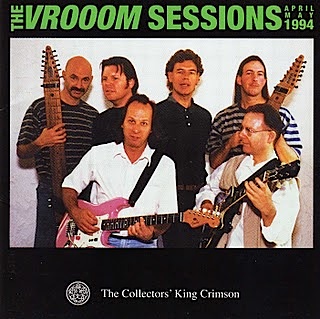
In late 1999, King Crimson’s collectors’ club put out a compilation of outtakes recorded by the band’s “double trio” lineup in 1994, titled The Vrooom Sessions. Several of these songs were later reworked or re-recorded for subsequent albums, but there are some neat cuts here. Considering these are not fully-formed songs, I won’t dwell on this release for too long.
“Bass Groove” is exactly what it advertises, with the overall atmosphere being dark and moody, and “Fashionable” is funky and could have fit in on Discipline. “Monster Jam” is too long, but it’s a great way for the two drummers to show off. Meanwhile, “Slow Mellow” takes its name too seriously and is an incredibly long three minutes. “Krim 3” is fantastic, with a jagged, bouncy groove. (It was later reworked for an Adrian Belew solo release.)
“Funky Jam” is fantastic, and…wait, I’ve heard this before! This is the “alternative version” of “Matte Kudasai”, isn’t it? At least, I thought it was, based on the version of the album I’ve had on my hard drive since 2010 or so. Was this just mislabeled?
Yes, it was. This is how I found out wherever I got my digital copy of Discipline from had a mislabeled song on it. Well, this is embarrassing. I looked up the real alternate version of “Matte Kudasai”, and it’s only minimally different from the canonical version. That is to say, I’m still not nuts about it. “Funky Jam” holds up, though, and I’m happy to have some proper provenance on this matter now.
“No Questions Asked” would eventually become “Sex Sleep Eat Drink Dream”, and an early version of “One Time” also appears here. “Calliope” is weird, bouncy, and too long; but it’s fun, and another great percussion showcase. The closing “Booga Looga” has a vaguely Western vibe to it, and it’s a decent enough cut.
The Vrooom Sessions is a pleasant collection. It’s far from essential, but it shows a side of King Crimson’s songwriting that isn’t just endless, airy improvisation.
During the time when the various ProjeKcts were performing and recording, Tony Levin left the band as well, bringing King Crimson to the quartet of Fripp, Belew, Gunn, and Mastelotto. This four-piece began recording their next album in late 1999.
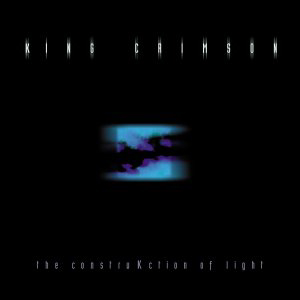
The resulting album, 2000’s The ConstruKction of Light, is not King Crimson’s best, and even Fripp acknowledged he was unhappy with the results. Somewhat unusually for King Crimson, none of this material had been played live before recording, and the songs feel overly reliant on past ideas.
ConstruKction opens with a song called “ProzaKc Blues”, and it’s not very good. It’s a somewhat tongue-in-cheek blues cut with industrial flavors, and Belew’s voice is distorted and pitch-shifted down. Despite Belew’s clever lyrics, this song is beyond saving.
The title track harkens back to the band’s ‘80s sound, with Belew and Fripp playing interlocking guitar lines. Overall, this cut lacks any real impact or power, and a lot of it comes off as limp math rock. Pat Mastelotto’s electronic drum kit doesn’t sound very good, either. Its first six minutes are repetitious, but once Belew’s voice comes in, that helps to save the last third of the song. “Into the Frying Pan” is better, channeling some early-to-mid ‘90s alt rock flavors, but it’s also too long.
“FraKctured” began life as a “Larks’ Tongues” sequel before Robert Fripp decided it was more of a sequel to “Fracture” off Starless and Bible Black. The opening of this one sounds very similar to this album’s title track, though some of the speedy riffing evoke moments in “Fracture”. The twinkly, clean guitar tones Fripp and Belew utilize here don’t really suit the music very well, and it robs it of any intensity. Mastelotto’s snare drum also calls to mind Lars Ulrich’s disastrous tone on St. Anger. There’s finally some distortion later on in the song. And while it does help with the previous lack of intensity, there’s something about this particular tone that is simply unpleasant. It’s frazzled and sharp, but more in a “crappy amp” kind of way than a “harsh experiment” kind of way.
Another blues-influenced song, “The World’s My Oyster Soup Kitchen Floor Wax Museum” showcases more of Belew’s quirky lyric-writing, but the musical backing isn’t great. It’s a noisy, jumbled soup that fails to make a splash.
What comes next is the 13-minute “Larks’ Tongues in Aspic (Part IV)”. The jagged riffs certainly call to mind prior entries in this series, but there’s a more industrial edge to the rhythm. I can’t exactly call it a rousing success. The composition isn’t bad, but the tone choices are questionable, especially with the percussion. Its outro features some synths that are uncharacteristic for this band, and this behemoth is beset by a sense of aimlessness.
The ConstruKction of Light ends with “Heaven and Earth”, which is credited to ProjeKct X. This piece has an urgent backbone, and I like it a lot. It’s a song where repetition and slow, incremental changes are utilized effectively. Its slow, synth-heavy outro is too long, but I’ll take what I can get on this album.
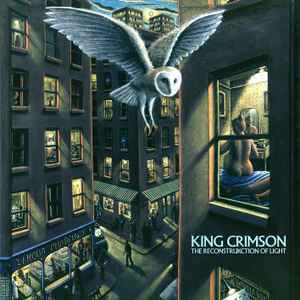
In 2019, King Crimson released The ReconstruKction of Light, a remastering/partial re-recording of The ConstruKction of Light. It certainly sounds better, especially in regard to the drums. Mastelotto used an acoustic kit on the re-recorded version, and it helped a lot. However, choices of sounds were only a portion of the problems plaguing ConstruKction; most of these songs just aren’t up to the band’s usual songwriting snuff. ReconstruKction is a mild improvement, but unless you feel more warmly toward this album than I do, it’s really not worth it.
Following The ConstruKtion of Light, ProjeKct X (the full quartet of King Crimson, just under a different moniker) put out a full album. Much like ProjeKct Two, it’s clear that this music stemmed primarily from jamming and experimentation, but it is notably better than Space Groove. The sound palette is more diverse and earthier, which works to the band’s strengths. Heaven and Earth, ProjeKct X’s sole album, is overlong, meandering, and generally unnecessary, but it’s got some good stuff scattered throughout.

“The Business of Pleasure” is a good, growling intro with industrial flavors. But the next couple tracks each meditate on one not-very-interesting idea apiece. “Maximizer” sounds like it could have been refined to fit in on a proper KC album, and the nine-and-a-half-minute “Strange Ears (Aging Rapidly)” is an alright jam.
There are some fun, wonky ideas in “Overhead Floor Mats Under Toe”, and “Six O’Clock” has a good, trudging rhythm. Most of these songs–especially the ones over three minutes long–go on for much longer than they need to, which hampers the enjoyability of this record. There’s too much muddy guitar noodling and too many vaguely-electronic beats that go nowhere.
“One E End” is especially electronic, even by this release’s standards, and “Two Awkward Moments” is a decent one-minute interlude. “Demolition” dwells on one riff for seven minutes when 90 seconds would have been fine.
The title track, which appeared on ConstruKction, is the penultimate cut. Heaven and Earth ends with “Belew Jay Way”. This torpid piece is your typical King Crimson jam, insofar as it hints at something interesting that may happen, but it instead simply lingers for too long without coming to a satisfying conclusion.
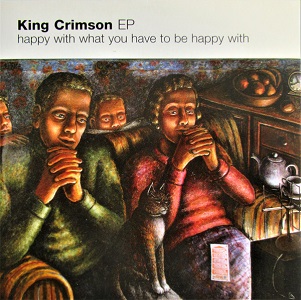
In 2002, King Crimson released a new EP: Happy with What You Have to Be Happy With. This release was recorded by the same lineup as ConstruKction, and it was meant to serve the same purpose as VROOOM: to act as a teaser for the upcoming full-length. Two of the songs here would appear on their next album, and there is also one live recording.
“Bude” is a 26-second intro of synthesized vocals that leads into the title track, which is nearly identical to the version on The Power to Believe.
“Mie Gakuri” is an airy instrumental interlude of wavering synth pads, “She Shudders” is another piece just like “Bude”, and “Eyes Wide Open” is a gentle bit of folky jazz-rock. It’s a pleasant little piece, and hearing King Crimson unplug for one song is a nice change of pace for the band. An electrified version of this piece appears on The Power to Believe. This is followed by “Shoganai”, an instrumental consisting solely of peculiar percussion reminiscent of a gamelan. I like it.
“I Ran” is yet another little synth-vocal piece. This is followed by “Potato Pie”, probably King Crimson’s bluesiest song. It still has some of that King Crimson strangeness, but it’s quite straightforward by this band’s standards. This song is decent, but really nothing special.
A live recording of “Larks’ Tongues in Aspic (Part IV)” comes next, and this takes up about one-third of the EP’s runtime. It is, as expected, a powerful, aggressive performance, but its placement on this disc feels a bit like padding.
The last track here is “Clouds”, one final synth-vocal interlude. It’s only 30 seconds long, but following a 30-second silence, the hidden track “Einstein’s Relatives” begins. (Man, I really do not miss hidden tracks being a thing. CDs have their uses, but unwieldy digital files with a minute of silence in the middle were not fun to deal with on iPod back when I was in high school.) After a brief, sped-up, one-man reprise of the title track, it wanders about rather aimlessly. There are a bunch of disjointed ideas, studio chatter, and general dicking-about. It feels like a piss take, and it really doesn’t offer much of interest.
Despite having some good ideas, this is quite the skippable release. I’m annoyed it wasn’t available to stream anywhere, so I had to spend a few dollars to buy a CD off Discogs. (This was actually one of four CDs I had to buy (along with VROOOM and ProjeKcts Two and X), but this was the most disappointing of the bunch. This one couldn’t even rip properly. And of course as I was formatting this, I found it actually is on YouTube, just with a truncated name that made it easy to overlook.)
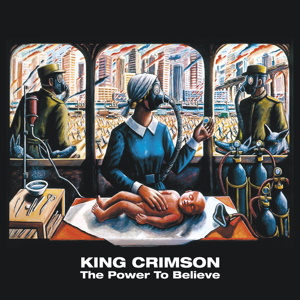
About a year after HWWYHTBHW, King Crimson put out their second full-length album in this configuration: The Power to Believe. It features the same line-up as ConstruKction, but it is considerably better. The album is weightier, and industrial elements are incorporated more fully.
The album’s title track is a four-part, 15-minute suite spread across the album. The first of these parts, “A Cappella” is a bit of synthesized vocals, like what we heard on the EP that preceded this album. This leads into “Level Five”, a live rendition of which was released ahead of this album on the live EP Level Five. This is meant to act as the fifth installment of “Larks’ Tongues in Aspic”, and the jagged, distorted guitars call to mind that ancestry. Mastelotto’s electronic percussion clicks and stutters anxiously, and the industrial inclusions are well-realized.
A much gentler track, “Eyes Wide Open”, follows. This cut ranks among the band’s strongest mellow pieces, with Belew’s vocal performance being especially effective. Creepy synth-reeds open “Elektrik” before moving into a jittery, industrial instrumental. This track melds the band’s ‘80s era guitar style with more electronic flavors wonderfully.
“Facts of Life” has an extended, creepy intro, but the song proper sticks to this album’s usual sound. It’s heavy, aggressive, and woven through with little electronic touches. The chorus is catchy, and the instrumental passages are dynamic and exciting.
Part II of “The Power to Believe” is its longest section. It’s a slinking, uneasy instrumental with some Middle Eastern touches. Mastelotto gets an opportunity to show off here by deploying a plethora of chimes, gongs, and other percussion instruments. The slow fade-in of “Dangerous Curves” builds tension. Structurally, this piece reminds me a lot of “The Talking Drum”. Everything keeps building and building to a sudden, powerful cessation of sound.
“Happy with What You Have to Be Happy With” comes next, and it’s one of my favorite (latter-era) songs from this band. It’s heavy and groovy, and Belew’s vocals are powerful and lightly distorted. His lyrics about songwriting are also characteristically somewhat silly.
The Power to Believe ends with the final two parts of its title track. “Part III” revisits the vocals from “Part I” and mixes them in among ominous, instrumental soundscapes in its first half. The second half is a slow, lurching instrumental that feels like a mix between this band’s mid ‘70s output and some of Pink Floyd’s spacier moments. “Part IV” is a quiet, droning piece that once more includes the first part’s vocal snippets. It adds a sense of calm finality to this record.
The Power to Believe is the last proper album from King Crimson, and I’m happy to say they went out on a high note. There is one more ProjeKct I need to cover, though: Jakszyk, Fripp and Collins. To explain this trio’s origins, we need to rewind slightly.
In 2002, four former members of King Crimson (Ian McDonald, Mel Collins, and Peter and Michael Giles) recruited 64 Spoons guitarist and vocalist Jakko Jakszyk to join them in an act called 21st Century Schizoid Band, which played music primarily off King Crimson’s first four albums. This band was live-only, and Michael Giles eventually left the band and was replaced by Ian Wallace, another ex-Crimson drummer.
At some point, Jakszyk met Fripp, and Fripp even made a guest appearance on one of Jakszyk’s solo albums. The two later recorded some jam sessions, and Jakszyk reworked them into songs. Mel Collins, upon hearing those recordings, offered to provide saxophone. For the resultant album, Tony Levin provided bass, and Gavin Harrison (Porcupine Tree’s drummer, who would later join King Crimson) added drums.
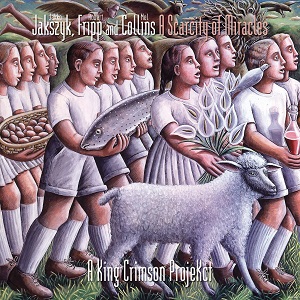
A Scarcity of Miracles (billed as “A King Crimson ProjeKct”) came out in mid-2011. It’s quite mellow and atmospheric, especially compared to King Crimson’s most recent releases.
It starts off with its title track. After an extended, mellow intro, a relaxed rhythm emerges, and Collins’s saxophone is a nice, smooth complement. Jakszyk’s voice is strong, and Harrison’s drumming provides just the right amount of propulsion. On the downside, this song is a bit on the long side, and that will be a common issue throughout this album. The underlying ideas are strong; they’re just stretched out a little too much.
“The Price We Pay” has a new wave feel to it at points, and Fripp’s soundscapes add a lot of depth. “Secrets” takes too long to get going, but its second half is strong. Harrison’s drumming is restrained but effective, and the harmonization of sax and distorted guitar works very well.
The introduction to “This House” is also overlong, though it does feature very pretty interplay between soundscape textures, wordless vocals, guitar, and sax. Once it gets going, it reminds me somewhat of the gentler moments on The Division Bell. The jazz flavors are nice, but this song is quite drawn out.
“The Other Man” features some interesting discordant stabs of guitar, and I appreciate that textural variation. Levin’s bass is impactful, and the percussion is also the most propulsive it gets on this album. Unsurprisingly, this is my favorite cut on the album. The bloat is minimal, and the contrast between the album’s overall gentleness and this cut’s aggression is smartly balanced.
A Scarcity of Miracles ends on its longest song, “The Light of Day”. Even by the standards of this release, the opening is spare. Jazzy guitar licks echo distantly, and Jakszyk’s vocals are only minimally-accompanied. This song frequently hints at interesting melodic ideas, but it struggles to fully realize any of these suggestions. The instrumental closing section is dark and imposing, while also being controlled.
Overall, A Scarcity of Miracles is a decent album, but it channels a lot of Robert Fripp’s tendencies toward ambient music and airy, jazzy improv. With that in mind, this could have been much, much worse, and if you’re looking for something subdued but dark, this is a decent choice.
Robert Fripp has disbanded King Crimson twice since their last studio album: once in 2008, and again in 2021. They were active as a touring band from 2012-2021, and that incarnation had seven members, including three drummers. King Crimson has ended a grand total of four times now, so they may re-form at some point. I doubt it, though, especially after watching the recent documentary about the band. They seem to have ended at a good place.
SeKction V: TL;DR and Ranking
Oh Jesus, that was a long one. Hopefully you enjoyed this exhaustive rundown of King Crimson’s studio output. In addition to their 13 studio albums and two studio EPs, this list also includes three ProjeKcts, one pre-KC recording, and a set of studio outtakes and jams. (I know there are many discs of King Crimson jamming, but that was a rabbit hole I’d rather not fall down. I debated even including the one I did, but I decided to stick with it.)
The music here ranges from King Crimson’s lush, symphonic early iterations, to the austere proto-metal of the mid ‘70s, to their dabblings in progressive new wave, to industrial semi-metal. There’s a lot here, and a lot of good stuff at that. But many releases were also hamstrung by Robert Fripp’s love for jazz improvisation.
- Larks’ Tongues in Aspic (1973) – 95/100
- Red (1974) 94/100
- In the Court of the Crimson King (1969) – 92/100
- Discipline (1981) – 86/100
- Lizard (1970) – 81/100
- The Power to Believe (2003) – 80/100
- THRAK (1995) – 79/100
- Starless and Bible Black (1974) – 74/100
- Beat (1982) – 71/100
- In the Wake of Poseidon (1970) – 69/100
- A Scarcity of Miracles (Jakszyk, Fripp and Collins) (2011) – 68/100
- The Cheerful Insanity of Giles, Giles and Fripp (1968) – 66/100
- VROOOM (1994) – 64/100
- Three of a Perfect Pair (1984) – 62/100
- The Vrooom Sessions (1999) – 58/100
- Islands (1971) – 55/100
- Happy with What You Have to Be Happy With (2002) – 46/100
- The ConstruKction of Light (2000) – 44/100
- Heaven and Earth (ProjeKct X) (2000) – 40/100
- Space Groove (ProjeKct Two) (1998) – 36/100
Considering the increased dialog surrounding plagiarism and citing sources online, I should say that most biographical information used in this Deep Dive (and the others) is from a combination of Wikipedia, liner notes in CD reissues I happen to own, and the documentary In the Court of the Crimson King: King Crimson at 50. The focus of this column is on music criticism, not history. The historical elements here are meant for context surrounding the criticism, and the criticism is my own.
One thought on “Deep Dive: King Crimson”